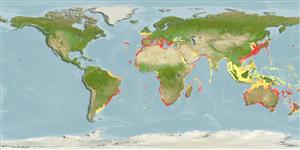Common names from other countries
Classification / Names / Names
Namen | Synonyme | Catalog of Fishes (gen., sp.) | ITIS | CoL | WoRMS
Environment: milieu / climate zone / depth range / distribution range
Ökologie
; tiefenbereich 5 - 750 m (Ref. 105665). Tropical; 51°N - 46°S, 68°W - 180°E
Indo-West Pacific, Atlantic Ocean and the Mediterranean.
Length at first maturity / Size / Gewicht / Alter
Maturity: Lm ? range ? - ? cm
Minimum depth from Ref. 82060. Bathyal. Inhabits continental shelf and slope (Ref. 2782). It is eurybathic, on coastal detritic bottoms to bathyal muds (Ref. 105665). Uses shells of Bittium latreilli (Ref. 105639). Opportunistic scavenger and predator. Feeds on live crabs, dead shells and fishes (Ref. 106108). Other isotope data (δ15N=9.66±0.25, Ref. 106518).
Life cycle and mating behavior
Geschlechtsreife | Fortpflanzung | Ablaichen | Eier | Fecundity | Larven
Members of the order Decapoda are mostly gonochoric. Mating behavior: Precopulatory courtship ritual is common (through olfactory and tactile cues); usually indirect sperm transfer.
Markham, J.C. 2003. (Ref. 2782)
IUCN Rote Liste Status (Ref. 130435)
CITES Status (Ref. 108899)
Not Evaluated
Not Evaluated
Bedrohung für Menschen
Harmless
Nutzung durch Menschen
| FishSource |
Tools
Mehr Information
Alter/Größe
Wachstum
Länge-Gewicht
Länge-Länge
Morphologie
Larven
Dichte
Internet Quellen
Estimates based on models
Preferred temperature
(Ref.
115969): 9.3 - 20.6, mean 14.8 (based on 532 cells).
